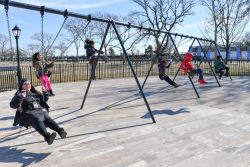Asser Levy Park
Asser Levy Park
What was here before?
Almost a century before its famous boardwalk opened along the Atlantic Ocean, Coney Island was on its way to becoming the nation’s most popular pleasure ground. It was first established as a seaside resort in 1824 and within a few decades Coney Island was attracting a steady stream of visitors. Railroad lines installed after the Civil War provided direct public transportation to a rapidly expanding list of attractions: restaurants, hotels, shops, and amusement rides as well as the beach and ocean.
How did this site become a park?
Originally known as Seaside Park, Asser Levy Park was acquired by the City of Brooklyn in 1876. Initially, the tract was 70 acres, but the park was more than halved over 25 years by “the ravages of the ocean,” particularly in a powerful storm in 1897. During this time the park “had been neglected and become a disgrace and a blot on the good name of that section of the City.” In response, a 60-man construction crew rebuilt the site in 43 days in 1902, and the park reopened that summer with 200,000 daily visitors. In 1912, the site of the former Dreamland Park was added to Seaside Park.
When the BMT subway was extended to the area in 1920, Coney Island became just a five-cent ride away from the city. On a hot summer day up to a million people might use Coney Island, which caused extreme congestion. The City secured title to property along the beachfront and begin beach improvement and construction on the boardwalk in 1921, ensuring public access to the beach and shore.
The land on which the aquarium sits was acquired by Parks in 1954. The New York Aquarium, operated with the New York Zoological Society (now the Wildlife Conservation Society), opened in Seaside Park in 1957. The facility served over 400,000 school children during the first school season it was open. The Society’s first aquarium was opened in 1896 in Battery Park in Manhattan from 1902 until it was forced to close in 1941 because of construction of the Brooklyn-Battery Tunnel. This aquarium replaced the former at Battery Park and was part of a larger plan to revitalize Coney Island.
The park’s bandshell was completed in 1975, and in 1977 Seaside Park was renamed in honor of Asser Levy, an early Jewish settler. For a decade, the Asser Levy Memorial Council advocated for a memorial and the park was selected because of the surrounding Russian Jewish population.
In 1999 the bandshell was renovated and named after Sidney Jonas (1904-1998), labor advocate and local leader who worked to bring musical talent to the park. Two decades later, the park playground was completely reconstructed with new separate play areas and swing sets, a spray shower, adult and tot-sized tables, and an adult fitness area.
Who is this park named for?
This park is named for the Asser Levy, who settled in the Dutch colony of New Amsterdam in 1654. Levy and a group of 23 Jews fled Brazil to seek refuge in New Amsterdam. Shortly after their arrival, Governor Peter Stuyvesant attempted to evict the Jews from the settlement. Levy became the colony’s first Jewish citizen and was the leading advocate of civil rights for Jews, challenging Stuyvesant on such issues as citizenship, the right to bear arms, and property ownership. He was the first Jew to serve in a militia and own property, the first kosher butcher in the New World, and a founding member of Shearith Israel in Manhattan, the country’s first Jewish congregation. A Roman-revival style bathhouse in lower Manhattan, designated as a city landmark in 1974, is also named for Levy.
Check out your park's Vital Signs
Clean & Safe
Green & Resilient
Empowered & Engaged Users
Share your feedback or learn more about how this park is part of a
Vital Park System










